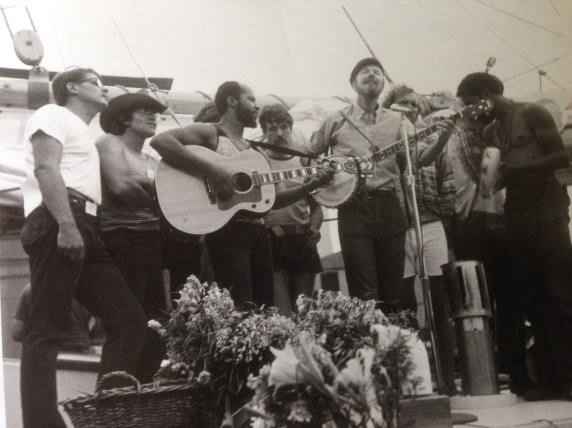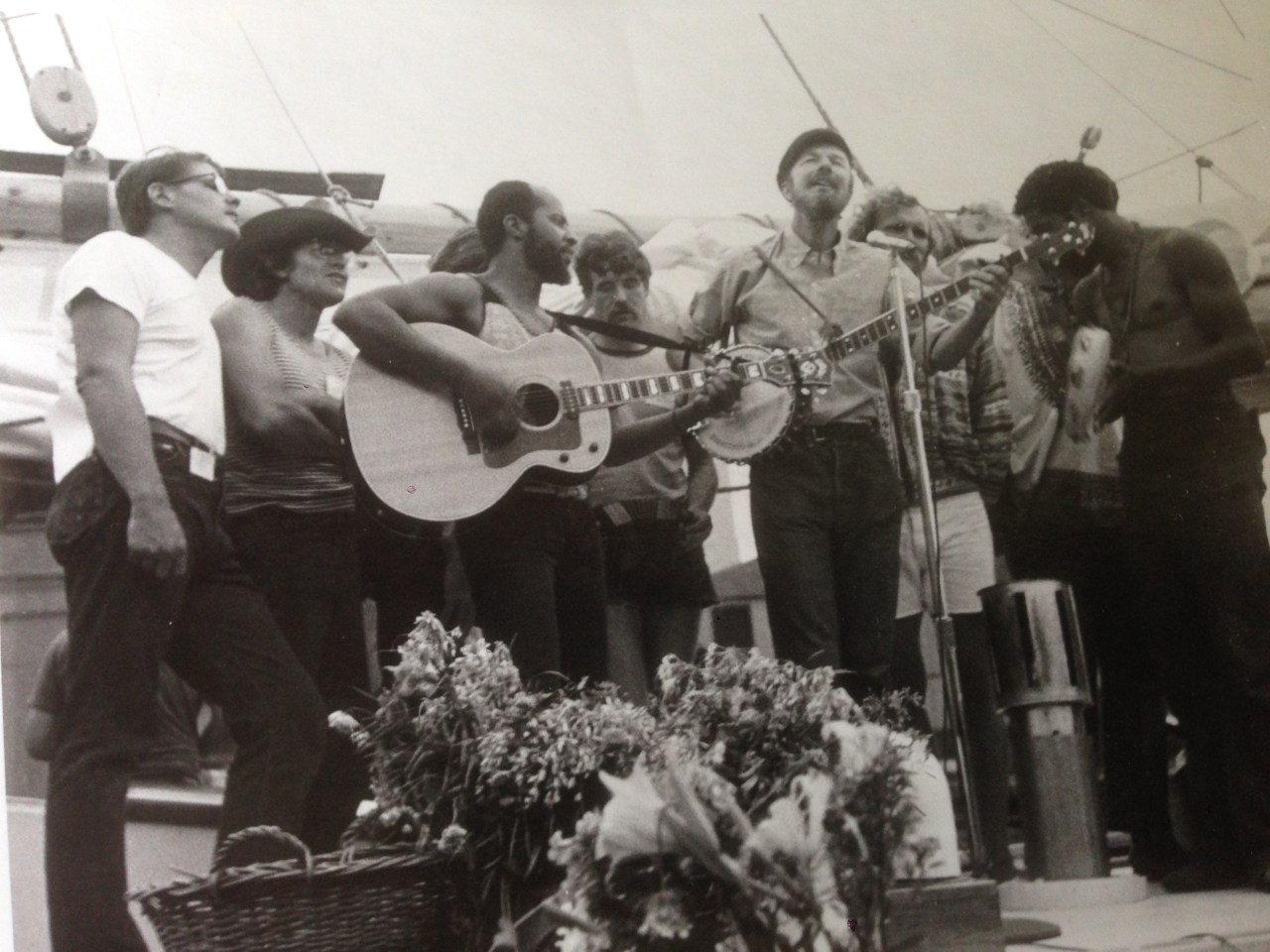Click here for the Spotify playlist.
In 1967, I was a student at Far Rockaway High School in Queens, New York. I was participating in anti-Vietnam War marches, with Phil Ochs’s sister, Sonny Ochs, who lived nearby, leading the requisite sing-alongs; spearheading a program to convince the community that permitting a Phoenix House drug rehab center in the area would be beneficial to the neighborhood; and walking past Sam Goody’s house nearby — yes, Sam of the then-small New York area Sam Goody record chain — who appeared to be pressing records in his garage. The sting of Mrs. Fink berating our 5th grade class at Beth El Day School for not having insisted our parents takes us to the March on Washington to hear Dr. Martin Luther King was still fresh. I wasn’t going to let these latter-day movements pass me by.

On the Hudson River sloop Clearwater, at Newport, RI, for the 1969 Newport Folk Festival. From left, Gordon Bok, Ramblin’ Jack Elliott, Len Chandler, Lou Killen, Pete Seeger, Jimmy Collier. Photo © Ira Mayer
I was already a pop culture junkie and opera lover, attending concerts at Izzy Young’s tiny Folklore Center, by then on Sixth Ave. in Manhattan (now in Sweden), Carnegie Hall, Brooklyn College, the Brooklyn Academy of Music and elsewhere. Apart from maintaining a journal, I started reporting on my escapades in the Rockaway Wave, which had bestowed a weekly column on me to write about high school. That happened to be the year of a city-wide teacher strike (two weeks in the fall of ’67, and then May through November of ’68). I had space to fill, and music and theater fit the bill as far as I was concerned. Conservative as the editors no doubt were personally, they left me to my (de)vices and published my early reviews.
That’s about when I started compiling my own songbook, pulling together the civil rights, anti-war and general social commentary songs that drove a budding liberal’s heart, guitar and banjo. I transcribed the lyrics by hand from LPs I purchased from the 25-cent cut-out bins at discount department store E.J. Korvettes, and, at substantially higher prices, at Sam Goody’s; at G. Schirmer’s, which specialized in sheet music but where you could listen to an album in a private, phone booth-size “room” before purchasing; and at Discophile, a basement record shop on W. Eighth Street in Greenwich Village known for its classical music imports.
Transcribing the lyrics meant picking up the tone arm on my turntable and putting it back down dozens of times for each song, then playing each back and editing. Occasionally I was lucky, and one of the songs was published in Sing Out! or Broadside, two earnest left-wing “folk music” magazines — though what constituted “folk” in a newly energized world of singer-songwriters was an on-going debate. Sing Out!, founded by Pete Seeger, Irwin Silber and others, and Broadside, run by wife and husband anarchists Agnes “Sis” Cunningham and Gil Friesen out of their apartment on the upper West Side of Manhattan, were open to anything left of left and an antidote to fan magazines such as Hit Parader, which published the lyrics to AM radio’s top 40 hits. There were also songbooks featuring early works of Tom Paxton and Phil Ochs.
When I arrived for freshman orientation at Hunter College, part of the City University of New York, in the summer of 1970, one of the elevators had just been tear-gassed as part of an anti-war protest. I’d entered from the Lexington Ave. side of the building so didn’t realize the school had been evacuated and my fellow students were all on the median on Park Ave. I wrote about the experience and mailed the article to the Village Voice, a weekly “alternative” newspaper. They weren’t interested. But shortly after, Bernie Klay, who ran the Sunday afternoon bluegrass and old-timey music concert series at the 23rd St. McBurney YMCA took me aside before a Doc Watson concert.
Bernie, like Izzy Young at the Folklore Center, had been letting me in for free as “press” thanks to my high school column in the Wave, taking care of me as they took care of many others, I would eventually learn, from the meager receipts of the concerts they produced that would attract anywhere from 12-150 people.
“Ira, it’s very nice that these reviews you write are in the Rockaway Wave, but how about trying the Village Voice or somewhere people will see them?”
“Who do I send them to?”
“Diane Fisher. 80 University Place. She’s the editor of the Voice music reviews.”
I wrote a review of the Doc Watson concert that Sunday afternoon and took it over to 80 University Place, where I pushed it under the glass door (the paper was closed weekends). That Wednesday I bought the Voice as I usually did — only this time, there was my review.
I went to something the following week (a Joan Baez concert, if memory serves) and pushed the review under the door the next Sunday. Wednesday came, and nothing. So I wrote another review (Michael Cooney, I think). And that Wednesday the Baez and Cooney reviews ran.
Was there an every-other-week pattern here? Who knew? I figured I’d see if one more review runs and then call and ask if I could get some money for transportation and tickets to concerts where I couldn’t get in for free. Living at home and commuting to Hunter, I checked in with my mother from a pay phone one afternoon.
“Ira, there’s an envelope here from the Village Voice. It looks like it might be a check.”
“HOW MUCH IS IT FOR?”
“I didn’t open it.”
“Of course you did. HOW MUCH IS IT FOR?”
“ $60.”
Was that for one review? Two? Did they count that second time I got published as one or two reviews? Was this coming out to $60 per review? $30? $20. I kept writing, putting the envelope under the door, eventually working out that it was $60 per “published occasion,” no matter the number of concerts. Driving from Belle Harbor in the Rockaways to Hunter on the upper East Side I wondered if I could get a press license plate that would let me park anywhere. (No.)
Two years went by of my reviews running initially every other week and ultimately weekly before I decided to press my luck and go meet Diane Fisher, my editor.
“Hi, I’m Ira Mayer,” I told the secretary. She started laughing. “What’s so funny?”
“You’re a real person! All this time we assumed you were a pseudonym for some other writer here, and that the checks we were sending out to Rockaway were to support some woman! I’m not going to announce you — just go in and tell Annie who you are.”
Twenty-one year old heart thumping, I introduced myself. I don’t remember much of the conversation, just that my mentor was very supportive and encouraging, and if I was going to Europe for the summer to music festivals, I should send what I wanted. No promises it would run, but when I got back she made clear I could continue what I’d been doing, writing about traditional American and international folk music, folk-rock, jazz, and, yes, rock and roll, learning about the music as I did so, as we all — the writers mining all this new music for inspiration and a living — did. Which was great, especially since by then I was contributing record reviews to the Sunday New York Times and a few other publications, as well as serving as business manager and sometime reviewer at the Hunter Envoy, the college newspaper where I made some lifelong friends.
It was another two years before Annie Fisher and I spoke again. In 1974, the Village Voice was sold by its founders to Clay Felker, who founded New York Magazine. The Voice’s founding editor and publisher, Dan Wolf and Ed Fancher, respectively, were going to be fired, she told me, and “when Dan is out, I’m out, and when I’m out, you’re out. Ross Wetzsteon [then the theater editor] is going to take over music and he hates the way you write.” Annie Fisher, wherever you are, thank you for an incredible start.
Fast forward.
In the late 1970s, I was hired by a collectibles company to come up with a list of the 100 Greatest Folksongs. Beyond the list they paid me for, the project never got off the ground, but it inspired me to look at that collection of protest songs I’d put together in the late ’60s. Maybe that could be issued on LP.
Mike Nadler, my lawyer then and still, never shy to give it to you straight, said, “The only one who will make any money on this is me. The rights clearances for what you want are complex, and Dylan and Peter, Paul & Mary don’t license recordings to others. Period.” End of dream for another 40 years. Today, it’s Spotify to the rescue. Of the 72 songs in that original collection, bound in a clip binder with a Work for Peace bumper sticker on the cover, 70 are on Spotify and on this playlist.
Not all the songs on the playlist are the versions I was listening to back then, but the songs themselves are. And, reflecting the period when this originally came together, it’s heavy on Paxton and Ochs. These were songs of solace and hope and determination and humor and beauty and defiance. We would sing and march our way to a better world.
Reading the unthinkable the news of today we need these songs, this spirit, as we did then.
I’ll be adding new playlists over time. Your suggestions, preferred versions, reminiscences, questions and your own shared playlists are invited in comments here and at ira@iramayer.com.
© 2017 Ira Mayer.







